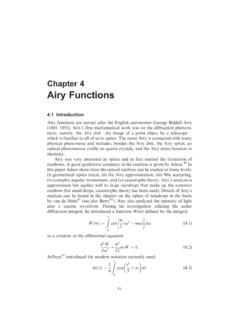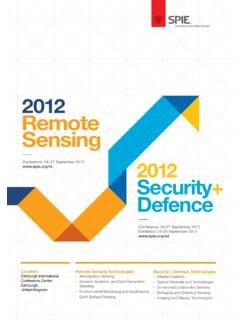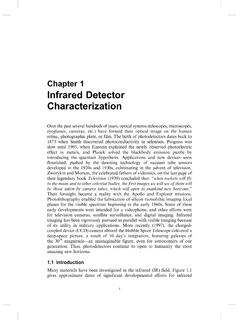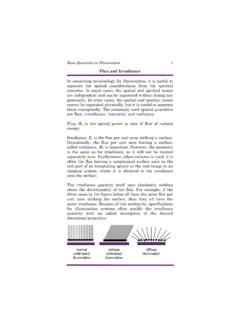Transcription of The concept of modes in optics and photonics
1 The concept of modes in optics and photonicsRen D ndlikerInstitute of Microtechnology, University of Neuch tel, CH-2000 Neuch tel, Switzerland*ABSTRACTThe concept of modes , or eigenfunctions, is fundamental for all wave phenomena in physics like optics , acoustics andquantum mechanics. In optics and photonics , the concept of modes is well suited to describe emission and absorption,coherence and interference, propagation and dispersion. The concept of modes consists of two aspects: first, the modes aresolutions for the propagation of the light; second, the number of photons in the different modes describes the transport ofenergy or information.
2 The energy density of the black body radiation, given by Planck's law, is the product of the densityof modes in free space and the average number of photons per mode, given by the Bose-Einstein distribution. The transverseshape of the modes is determined by diffraction and boundary conditions. The longitudinal extension is given by thecoherence : modes , eigenfunctions, diffraction, coherence, interference, dispersion, waveguides, Planck's law, lasers1. INTRODUCTIONThe concept of modes , or eigenfunctions, is fundamental for all wave phenomena in physics like optics , acoustics andquantum mechanics.
3 In optics and photonics , the concept of modes is well suited to describe emission and absorption,coherence and interference, propagation and concept of modes consists of two aspects: first, the modes are solutions for the propagation of the light; second, thenumber of photons in the different modes describes the transport of energy or information. The energy density of the blackbody radiation, given by Planck's law, is the product of the density of modes in free space and the average number ofphotons per mode, given by the Bose-Einstein distribution.
4 The transverse shape of the modes is determined by diffractionand boundary conditions. The longitudinal extension is given by the coherence length. They following properties and lawsare related to modes : Modesare orthogonal; they do not interfere. Onlythe light (photons) within one and the same mode is coherent and does interfere (for identical polarization). Differentmodes may have different phase and group velocities (dispersion). Thequality of light is given by the number N of photons per mode: N <<1for thermal sources and N >>1for lasers. Theshape of modes may be changed by passive optical elements ( lenses , mirrors , filters), however, the number N ofphotons per mode cannot by increased.
5 Theenergy throughput of an optical systems depends on the number of supported modes and the adaptation of the modesbetween the different sections of the system. Noisein coherent electro-optical detection depends on the number of photons per are the reasons why I believe that introducing the concept of modes is most adequate for education in optics andphotonics at least at a university DEFINITIoN OF MODESThe modes are basically defined by the properties of coherence and orthogonality: modes are orthogonal solutions of thewave equation, they do not interfere (the energy or optical power of a linear superposition of modes is equal to the sum theenergy or the optical power of the individual modes ).
6 Only the light (photons) within one and the same mode is coherentand does interfere. Two types of modes are distinguished: spatial modes transverse to the direction of propagation (cross-section and divergence) and temporal modes in the direction of propagation (time and frequency).*Correspondence:Email: WWW: International Conference on Education and Training in optics and photonics ,J. Javier S nchez-MondragOn, Editor, SPIE Vol. 3831 (2000) 0277-786X1001$1 Spatial modesSpatial modes are defined by the diffraction limit. The prototype of a spatial mode is the Gaussian beam, shown in Fig.
7 Diffraction limited divergence 0 is given by=lim=_2_,(1)Z *ooZicwwhere ? is the optical wavelength. In two dimensions wegetAM o2andM 2(2)for the cross-sectional area AM and the solid angle MFrom Eqs. (1) and (2) we see that the product of area AM and the solid angle M is constant, namelyLAMM=X2(3)which is the basic definition of a spatial mode. The exact shape of modes depends on boundary conditions ( waveguides,laser resonators) and can be changed by optical elements. However, for the use in the following discussions, only theproperty given in Eq.
8 (3) is relevant and needed. This property means, that a mode occupies in the "phase-space" (transverseposition and momentum of the corresponding photons) always the same Temporal modesThe definition of temporal modes can be based on the Wiener-Khinchin theorem, which relates the temporal coherencefunction JT(t) and the power spectral density S(v), or often simply called the spectrum, byr(t) =<V(t+t)V*(t)>=$dvS(v) e2t(4)where <V(t+t)V*(t)> is the autocorrelation function of the complex amplitude V(t), tisthe time delay and V is the opticalfrequency.
9 For a rectangular spectrumP0 fv v\S(v) =-;; rectI)(5)ofwidth iv we get from Eq. (4) the coherence functionr(t)=po5in(Tht) .(6)itEvtFromEq. (6) we see that the coherence becomes zero for iVt=1,whichgivesVMtMl(7)forthe basic definition of a temporal mode. This property means that photons within one temporal mode cannot bydistinguished by their energy the interested reader and for completeness only, it shown in the following how for more general power spectraldensity functions S(v) the values of LvM and LtM have to be defined. These definitions are based on the Wiener-Khinchintheorem, already introduced in Eq.
10 (4). In the general case, the coherence time is defined bytM =5dtI2,(8)where y(t)= IT(-r)IF(O)is the normalized coherence function. The corresponding definition of the spectral width is then194 Fig. 1. Gaussian beam as prototype of a spatial (v)i(9)\O)wheres(v) =S(v)/F(O)=S(v)/P0is the power spectral density normalized to the total optical power Basic properties of modes (spatial and temporal) Lightwithin one mode is coherent (for identical polarization). Lightfrom different modes is incoherent, does not interfere (orthogonality). Photonswithin one mode cannot be distinguished (uncertainty relation).













